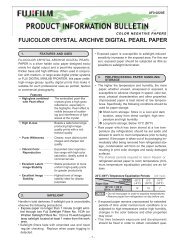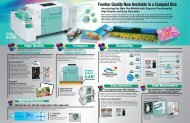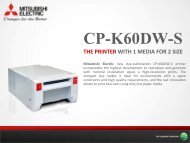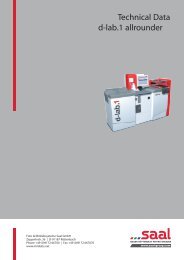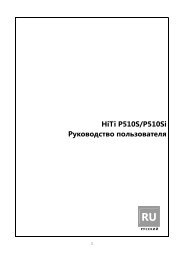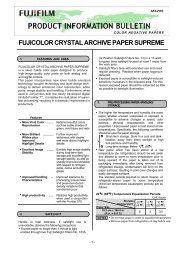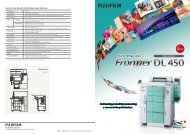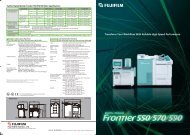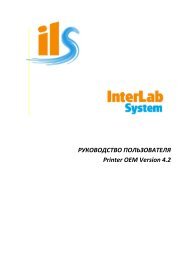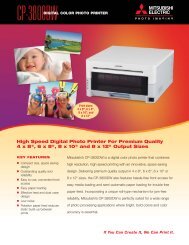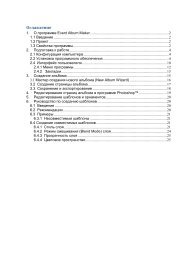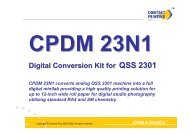FUJICOLOR CRYSTAL ARCHIVE PAPER - Macodirect.de
FUJICOLOR CRYSTAL ARCHIVE PAPER - Macodirect.de
FUJICOLOR CRYSTAL ARCHIVE PAPER - Macodirect.de
Create successful ePaper yourself
Turn your PDF publications into a flip-book with our unique Google optimized e-Paper software.
FUJIFILM PRODUCT INFORMATION BULLETIN <strong>FUJICOLOR</strong> <strong>CRYSTAL</strong> <strong>ARCHIVE</strong> <strong>PAPER</strong><br />
If exposed paper remains unprocessed for exten<strong>de</strong>d<br />
periods of time un<strong>de</strong>r normal room conditions or is<br />
subjected to high temperature and/or high humidity,<br />
changes in the color balance and other properties<br />
may occur.<br />
The time between exposure and <strong>de</strong>velopment<br />
should be fixed in or<strong>de</strong>r to obtain consistent quality.<br />
Avoid waiting until the next day to <strong>de</strong>velop the exposed<br />
paper. Rather than holding the paper for processing<br />
the next day, initiate processing as soon as<br />
possible.<br />
4. PROCESSING<br />
This paper is <strong>de</strong>signed for use with <strong>FUJICOLOR</strong> Paper<br />
Process CP-40FA, CP-43FA, CP-47L, CP-48S, and<br />
CP-49E, or RA-4 type processes.<br />
5. POST-PROCESSING <strong>PAPER</strong> (PRINT)<br />
HANDLING/STORAGE<br />
Since prints are usually used for the long-term recording<br />
of images, as much effort as possible is ma<strong>de</strong> to use<br />
materials that exhibit the least amount of change over<br />
time, but the effects of light, heat, oxygen in the air, contaminating<br />
gases, humidity and mold cannot be completely<br />
avoi<strong>de</strong>d. It is possible, however, to minimize the<br />
change in the photographic image or base material by<br />
maintaining the appropriate storage conditions for<br />
prints, such as those used by museums and art galleries.<br />
Temperature and humidity control is the most important<br />
key to minimizing the change that occurs in<br />
prints. Prints stored in the dark un<strong>de</strong>r the following conditions<br />
may be expected to show almost no change<br />
over time.<br />
Storage Period with<br />
Almost No Change<br />
Temperature Relative Humidity<br />
More than 20 years Below 10°C (50°F) 30% — 50%<br />
10 — 20 years Below 25°C (77°F) 30% — 50%<br />
Notes on Print Storage<br />
1 Prints should be inserted into albums, mounted, or<br />
placed into a bag (plastic*) for photographic prints<br />
before being stored.<br />
*Ma<strong>de</strong> of polyester, polystyrene, polyethylene,<br />
or polypropylene plastic, etc.<br />
2 Even during normal storage, it is recommen<strong>de</strong>d that<br />
prints be stored at a place as free as possible from<br />
hot and humid conditions, and away from direct sunlight<br />
and other strong light or from direct illumination.<br />
The following are examples of un<strong>de</strong>sirable storage<br />
conditions.<br />
– 2 –<br />
Storage in a room closet facing a wall exposed<br />
to cold outsi<strong>de</strong> air (which may cause con<strong>de</strong>nsation).<br />
Storage in a place near the ceiling, such as an<br />
attic, the top of a closet or cupboard (where high<br />
temperatures may occur).<br />
3 Storing prints with their front surfaces facing each<br />
other may result in unexpected problems. For this<br />
reason, prints should be stored with their front surfaces<br />
facing away from each other. If the adjacent<br />
print placement is unavoidable, it is necessary to<br />
keep the surfaces separated by, for example, the use<br />
of interleaving sheets of paper.<br />
6. LIGHT SOURCES FOR VIEWING<br />
When inspecting finished color prints, it is essential that<br />
an illumination source be used that has superior spectral<br />
characteristics, a<strong>de</strong>quately high color temperature<br />
and sufficient brightness. This is because results can<br />
appear different, <strong>de</strong>pending on light quality. For precise<br />
results, prints should be examined un<strong>de</strong>r the conditions<br />
<strong>de</strong>signated by ISO 3664-2000. As a general gui<strong>de</strong>, the<br />
following conditions are recommen<strong>de</strong>d.<br />
Color Temperature : 5000±300 K<br />
Average Illumination : 500 Lux or more<br />
General Color Ren<strong>de</strong>ring In<strong>de</strong>x: Ra 90 or more*<br />
* To attain these values, special fluorescent lamps <strong>de</strong>signed<br />
for color evaluation (e.g. EDL type) should be used.<br />
When inspecting finished prints, be careful to shut out<br />
all external light and colored reflected light.<br />
7. USE WITH FRONTIER 3**/5**/7**<br />
Please refer to the following calibration data as a general<br />
gui<strong>de</strong> when using <strong>FUJICOLOR</strong> <strong>CRYSTAL</strong> <strong>ARCHIVE</strong><br />
<strong>PAPER</strong> on a digital printer.<br />
All Frontiers requires a <strong>de</strong>dicated LUT when printing.<br />
This <strong>de</strong>dicated LUT is available on installer A3, version J<br />
and higher For availability of this CD, please contact<br />
your local distributor.



